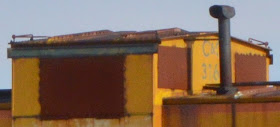 |
| 20150210 0001c |
I wasn't willing to tromp into snow to get a completely clear view, so I took shots from a couple of locations in the parking lot. I also took an overview shot to provide some context (below). The bridge in the background is I-475.
Of particular importance is that playground equipment on the left. To get to this parking lot, I had to drive past an intimidating water tower because of the fence around it. And then I saw a sign indicating that the first parking lot I stopped in was for fire fighters. But then I noticed if I drove all the way towards the tracks, I was in a parking lot labeled for the playground. I was relieved that I could park legally and take my sweet time taking pictures.
 I spotted the original C&O number on the copula -- 3161. (The black thing on the right in the closeup of the C&O marking is the smoke stack.) I wonder why it was renumbered with the reporting mark CO instead of CSXT.
I spotted the original C&O number on the copula -- 3161. (The black thing on the right in the closeup of the C&O marking is the smoke stack.) I wonder why it was renumbered with the reporting mark CO instead of CSXT. I had assumed that this caboose was used like the caboose on FFG&C trains or the second engine on the BNSF/CB&Q "flour local" --- an observation platform for when the train is being run in the reverse direction. But it was obvious they were not looking from the comfort of the copula because the windows were plated over. But then I noticed the end windows are boarded up as well. So now I don't know what the caboose is being used for in this local.
(Update: the purpose is to provide a platform for the crew when the train is backing up. In fact, they are now called "shoving platforms." And I learned from the following comment on Facebook that some railroads feel their employees have to be uncomfortable in order to do their job safely.
Robert Bufkin If a train has a lot of backup moves such as locals or it can't turn at the end of a line they still use these. They are suppose to have the doors locked so the crew rides the ends but I know some crews that break in to stay out of the elements. And they are now called shoving platforms.)
The tracks are part of the CSX/B&O route between Dayton and Toledo via Lima. On a satellite map, I followed the tracks toward Toledo and found some other industrial leads.
- Tri State Forest Products
- Master Chemical Corporation
- Lucky Farmers (grain elevator)
Update:
 |
| Mike Chisum posted Not sure why the caboose was in the middle of the train. Paul Treat That is not a caboose it is a "shove platform." Trainman can claim extra pay if required to shove more than a mile, riding on side of a car, If railroad provides a shove car them no basis for claim.Mike Chisum The farthest they may go is 20 miles one way. [If it is a shoving platform, it is interesting that the copula windows are not also boarded up.] |
An example of why shoving platforms are needed for local switching.
 |
| Todd Pendleton posted Inbound Amtrak train, Sep. 19, 1996, Chicago, Ill. Steven Holding A Bio-Fred on the rear?? Earl Sproule Jr. Been there done that,but I wouldn't recamend it! |
 |
| Dennis DeBruler commented on Todd's posting David Daruszka I was thinking he would have to use an end ladder. That is why I mentioned the clearance issue. It does not look like there is enough room between the car and bridge to safely ride on a side ladder. Although that bridge is big, maybe there is. It makes me appreciate why I sometimes see a "No Clearance" sign posted on the edge of a building next to an industrial siding. David Daruszka I forgot that part. Clearance is an issue and the end ladder would have been a better alternative than riding in the center of the car. |
A discussion of the BNSF local that goes south of Joliet with a shoving platform that is painted in Santa Fe colors.





Great post! I always thought cabooses were completely phased out, so it was interesting to learn they’re still around in some local operations. The history behind their use and how they’ve adapted over time really adds a layer of nostalgia. Loved the photos too – proper bit of railway charm. Thanks for sharing!
ReplyDelete